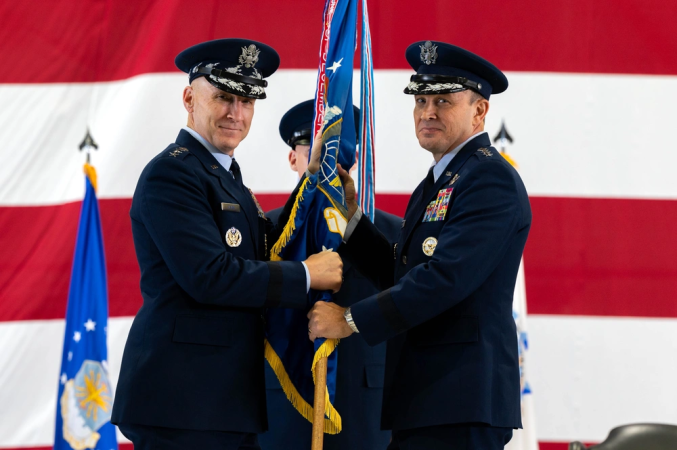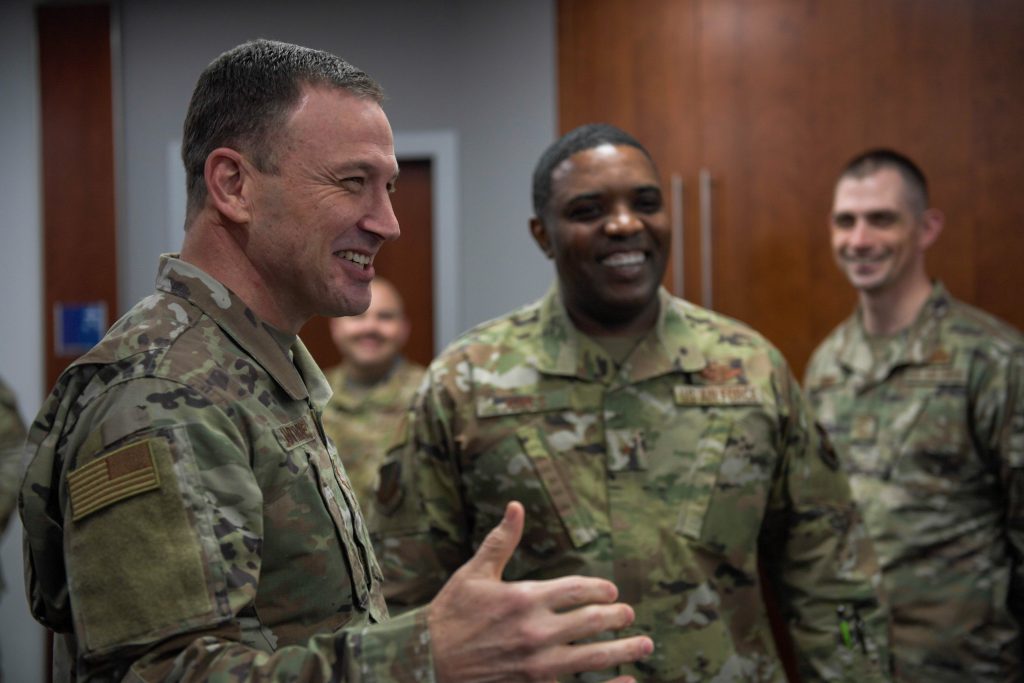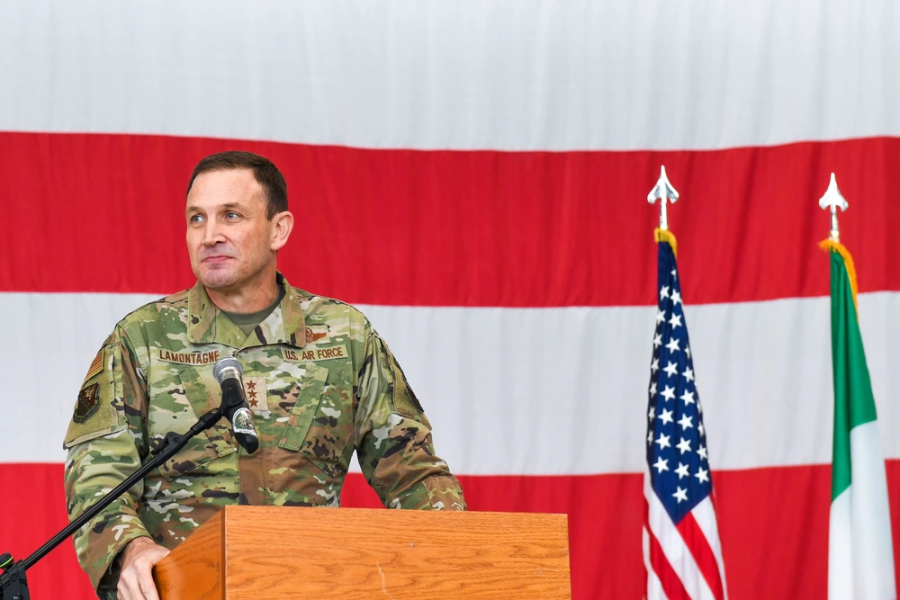A few months after the U.S. invaded Afghanistan in 2001, Capt. John D. Lamontagne was a C-17 pilot at Charleston Air Force Base, S.C., where he and his fellow Moose drivers started flying with night vision goggles to prepare for blacked-out landings in the Middle East in the new Global War on Terror.
“At the time, night vision goggles were a mission set for our most experienced crew members,” Lamontagne, now a four-star general and the new head of Air Mobility Command told Air & Space Forces Magazine 23 years later. “9/11 basically drove the whole team at Charleston, and then I’d say probably across Air Mobility Command, to be qualified on NVGs … it didn’t turn night into day, but it was very much a key enabler to do what we needed to do at a lower level of risk.”
So when Lamontagne’s squadron commander asked if he’d be interested in flying a special operations team to Kandahar in the early months of the war, Lamontagne said he was ready to go. But since he was working directly for the wing commander at the time, he had to get the colonel’s permission first.
“The wing commander did not let me get out from behind that desk,” he said. It was a letdown, but the point remains: the young pilot was ready to fly a new mission for a new war the nation was fighting. Likewise, Lamontagne wants the 107,000 Airmen and 1,100 aircraft now under his command at AMC to be ready for the next conflict, even if it breaks out today.
“The crews can only operate with what they have, the forces can only operate with what they have,” he said. “As far as flying, fighting, winning tonight, we can only do it with what we have tonight.”

The fight in question is a potential conflict against near-peer rivals such as China and Russia. Officials say it will require new technology, new tactics, and a new mindset about what it means to deploy. On top of that, AMC must also meet an insatiable demand for airlift and aerial refueling as the U.S. military responds to conflict and natural disasters around the world.
To make things even more complicated, Lamontagne will also have to navigate a new place for AMC as the Air Force pursues a sweeping reorganization to prepare for near-peer conflict. In the reorg, some major commands will become institutional commands, responsible for organizing, training, and equipping forces, while others will be service component commands, responsible for presenting forces to joint combatant commands.
AMC is one of those service component commands, charged with presenting forces to U.S. Transportation Command, while the new Integrated Capabilities Command will oversee force modernization efforts for the entire service, including AMC.
It’s a lot of change, but the months after 9/11 saw a lot of change, too.
“The commanders laid out the vision for what we needed to be able to do, identified the risk they were willing to accept, gave the team some pretty wide swim lanes to go do it, and we went and did it,” he recalled. “It was a very empowering atmosphere which allowed the good ideas to bubble up from the bottom up, in accordance with their vision.”
Lessons Learned
Before moving back to Scott Air Force Base, Ill., for the AMC job, Lamontagne’s old post was in Germany, where he spent the past three years as chief of staff for U.S. European Command and then as deputy commander for U.S. Air Forces in Europe-Air Forces Africa.
It was a busy time to be in Europe; about eight months after Lamontagne became chief of staff, Russia launched its full-scale invasion of Ukraine, raising tensions across the continent and prompting a wave of Air Force-borne supplies and equipment for Ukrainian troops that continues to this day.
One of the lessons the general has taken away from the war is the importance of air refueling tankers, which keep the fighters flying so they can achieve air superiority. Neither side in Ukraine controls the skies, which officials say has contributed to its yearslong grind.
“There are some strong threats in both Europe and the Pacific that have been designed to take away that very asymmetric advantage that we have with rapid global mobility,” said Lamontagne, who started his career as a KC-135 tanker pilot. “It is really central for us to work air refueling … so that we can negate those defenses and continue to provide air superiority so that our forces can win.”
The other lesson he took away from Ukraine is the proliferation of small uncrewed aerial vehicles that can strike or spy on enemy targets. Airmen are not typically trained or equipped to sense and counter those threats, Lamontagne said, but they need to be going forward, both at home station and while deployed.
Beyond warfighting, Lamontagne wants to give mobility Airmen the opportunity for rewarding experiences in uniform. For his part, the general looks back fondly on his time as assistant operations officer, then operations officer, then commander of the 15th Airlift Squadron at Charleston both at home and on a combat deployment from 2007 to 2010.
“The absolute professional highlight of my career, probably until now,” he said. “Never in my wildest dreams would I think that I would be here, but I look forward to setting the conditions for others to have the same level of success or more that I was able to enjoy.
“The good old days are today, right?” he added. “Today is the good old days for the captains, the NCOs, the Airmen. So I want to set a culture that will let them thrive in their personal environment and thrive in their work environment. That is what we are aspiring to do.”

Fight Tonight
Lamontagne has two buckets for priorities: acquisitions and operational. Acquisition includes programs such as the Next Generation Aerial refueling System (NGAS) and “25 by 25,” an effort launched by his predecessor, Gen. Mike Minihan, to upgrade the fleet with secure, beyond-line-of-sight communications.
While it’s not clear when those capabilities will arrive, the general wants to take a more deliberate approach towards prioritizing which airframes get connectivity first and how Airmen employ, sustain, and train on them. He has already met with Maj. Gen. Mark Mitchum, the head of the newly-established Integrated Capabilities Command, which will coordinate the Air Force’s modernization efforts.
The conversation was “a great opportunity to say ‘hey, we’re going to send you our talent so that you can develop those interoperable systems, not just in one portfolio, but across, so that we can have one Air Force,’” Lamontagne said.
Meanwhile, the operational bucket includes the tactics and techniques that Airmen can work on today to be ready to “fight tonight,” he explained. For example, Minihan pushed AMC’s ability to “explode into theater,” meaning they can quickly get from home station in the continental United States out to the distant frontlines where they are needed most.
“There’s probably going to be a healthy amount of continuity with what Gen. Minihan had already put in place,” Lamontagne said.
The general also wants to better integrate AMC’s Illinois-based 618th Air Operations Center (AOC) with the Hawaii-based 613th AOC, which oversees Air Force operations in the Indo-Pacific, and the Germany-based 603rd AOC, which does the same for Europe and Africa.
Doing so will align AMC’s time and tempo with the commands where the next conflict may break out.
“We will certainly need to project forward, but we’re going to need to be able to sustain them on their timing and tempo, and I think there’s some work to do to strengthen that alignment and integration across our C2 formations,” he said.
At the same time, Airmen have to be ready to carry out their commander’s intent even when communications have been cut off by the enemy. It’s another skill that AMC can train on now, because conflict could break out any time, Lamontagne said.
“You can only train with what you have,” he explained. “We, the headquarters, are going to work those acquisition pieces and eventually provide that capability. But if it doesn’t deliver until tomorrow, figuratively, it doesn’t help those squadrons tonight. So we’re going to focus on tonight.”


